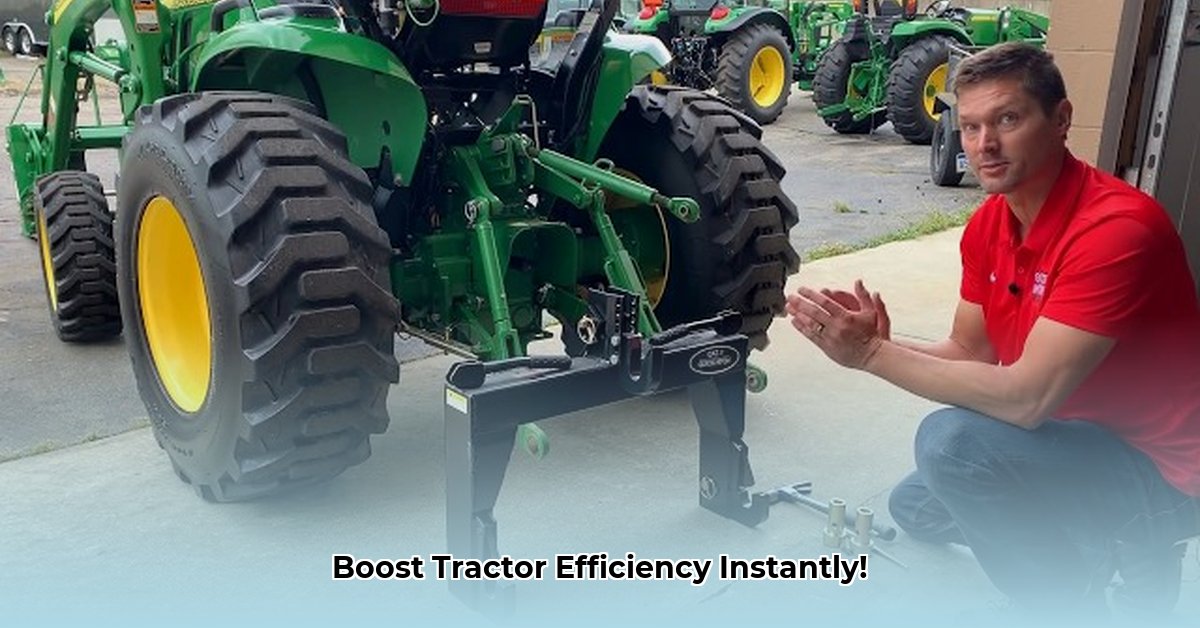
Streamlining Your Workflow: An In-Depth Look at Tractor Implement Quick Connects
Tired of wrestling with cumbersome PTO hookups? Switching implements shouldn't be a workout. Tractor implement quick connects promise a faster, safer, and more efficient way to manage your equipment. But are these systems worth the investment? This review delves into the specifics, offering a comprehensive guide to installation, usage, and potential challenges.
For more on quick-hitch alternatives, see this helpful resource.
How Quick Connects Work: Simplicity and Strength Combined
Quick connect systems utilize precisely engineered couplers on both your tractor and implements, creating a seamless and secure connection. These couplers manage power transfer (PTO – Power Take-Off) and hydraulic connections, significantly simplifying the traditionally time-consuming process. Think of it as a precision-engineered "snap-together" system for your tractor attachments; less wrestling, more farming.
Installing Your Quick Connect System: A Step-by-Step Guide
Safety First! Always ensure the tractor PTO is disengaged and the engine is off before beginning any installation or adjustment. Failure to do so can lead to serious injury.
Step 1: Preparation: Clear the area around the tractor and implement. Double-check that all power sources are disconnected and secured.
Step 2: Alignment: Carefully align the implement coupler with its counterpart on the tractor. A smooth, effortless connection is key; forcing it indicates a problem.
Step 3: Connection: Follow the manufacturer's instructions closely. Most systems have an audible "click" or visible locking mechanism indicating a secure connection.
Step 4: Inspection: Visually inspect the connection. It should be firm, snug, and properly aligned. Double-checking will prevent potential problems later.
Step 5: PTO Engagement: Only after visually confirming a secure connection, engage the PTO and begin operation.
Weighing the Pros and Cons: Is it the Right Choice for You?
Quick connect systems offer significant advantages, but also present some limitations. Consider these factors carefully to determine if a quick connect system is the right fit for your needs.
Pros:
- Significant Time Savings: Reduces implement changeover time, maximizing your workday productivity. How much time will you save? Consider this a major return on investment.
- Enhanced Safety: Simplifies the connection process, minimizing the risk of injury from heavy lifting or awkward maneuvering.
- Ease of Use: Intuitive design makes these systems user-friendly, even for less experienced operators.
- Reduced Equipment Wear: The smoother connection process may contribute to reduced wear and tear on both your tractor and implements.
Cons:
- Higher Initial Cost: Quick connect systems represent a greater upfront investment than traditional methods.
- Compatibility Concerns: Not all tractors and implements are compatible. Verify compatibility before purchase. Adapters may be needed, adding cost and complexity.
- Potential Repair Challenges: Repairs may require specialized tools and expertise, potentially increasing downtime and repair costs.
- Minor Learning Curve: While generally user-friendly, a brief learning period may be necessary to fully understand the operation of a specific quick connects system.
Driveline Length Adjustment: A Crucial Step for Optimal Performance
Adding a quick connect system alters the driveline length. This extra length—usually 4.5 to 5 inches—requires careful adjustment to prevent binding, vibration, and potential damage. A precise, two-step measurement process is essential.
Step 1: Initial Measurement: Measure the current driveline length from the PTO to the implement's input shaft.
Step 2: Adjustment Calculation: Subtract 4.5 to 5 inches from this measurement to account for the quick connect's added length. Compare this to your implement's ideal driveline length (found in your manual). Shorten the driveline if necessary, using appropriate tools and exercising extreme care.
Important Note: Always consult your implement’s manual for precise driveline length specifications and safe shortening techniques. Improper adjustment can lead to serious equipment damage and safety hazards.
Alternative Solutions: Quick-Hitch Systems
Consider a quick-hitch system as an alternative. These systems offer streamlined implement changes without requiring driveline adjustments. They may be a superior option if you frequently change implements.
Is it Worth the Investment? A Cost-Benefit Analysis
The decision hinges on your specific needs and operational scale. For large farms with frequent implement changes, the time and safety advantages can easily outweigh the higher initial cost. However, for smaller operations or those with infrequent implement changes, the investment might not offer sufficient returns. Carefully weigh the potential benefits against the upfront cost and potential challenges. Remember to factor in the cost of downtime.
"The return on investment for quick connects hinges on the frequency of implement changes and the value of your time," says Dr. Emily Carter, Agricultural Engineering Professor at Purdue University.